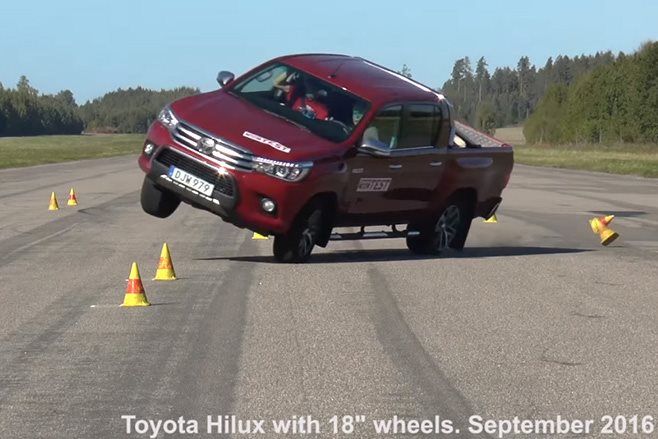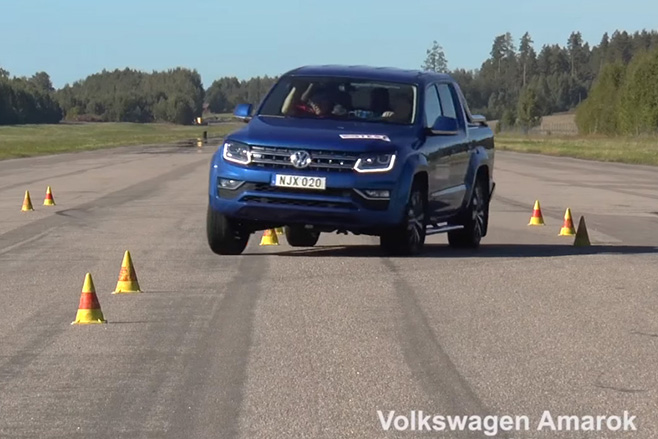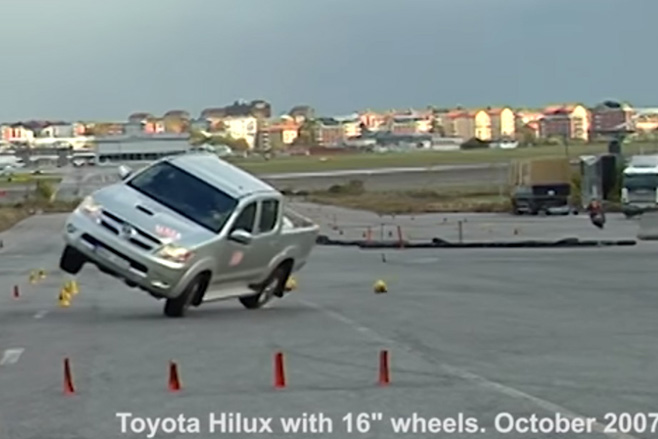
Serious safety questions have been raised about the Toyota Hilux after the trade ute almost turned turtle while performing a low-speed swerve test – almost a decade after the previous-generation model came even closer to doing the same thing.
Swedish magazine Teknikens Varld questioned the Hilux’s safety record after posting video of the trade ute – carrying weights in the tray and five passengers that brought it close to its maximum payload – tipping up on to two wheels and almost high-siding while being driven through a moose swerve test at 57km/h; a defensive driving manoeuvre designed to simulate driving around an animal that has wandered onto the road.
The dramatic result was attributed in part to the tyres fitted to the 18-inch alloys – the brand of tyre fitted to the Swedish test cars isn’t mentioned – with a re-test on 17-inch rims showing slightly more stability, although again the ute comes close to rolling before the driver countersteers out.
The Hilux should have performed like the other heavily loaded utes on test (pictured below), the magazine’s driver who uncovered the stability issue, Ruben Börjesson, said.

“If that would be the case the suspension should have bottomed out but it didn’t,” Börjesson said. “Instead I think the problem lies in the absence of anti-rollover systems and the grip of the tires.”
The test on the Hilux was in stark contrast to five other dual-cab trade utes run through the same manoeuvre, including the Ford Ranger, Mitsubishi Triton and Volkswagen Amarok.
“When the limit of grip is reached the [other] pick-ups just understeer straight ahead. But not when the test team enters the new Hilux Toyota,” Teknikens Varld said.
“Something is seriously wrong with Toyota’s dynamic safety system, and the result is dependent on the tires the car is equipped with,” it concluded. However, it does not mention the brand of the tyres fitted to the test cars.
The unexpected result is almost as spectacular as a similar test with the previous-generation Hilux held in 2007. In the earlier test, the Hilux gets to an even more extreme angle before the driver countersteers out of trouble.

The Toyota Hilux has earned a top five-star safety rating in Australia, although in a test designed to see how it performs in a crash, not how it performs dynamically. The Australasian New Car Assessment Program that assesses the crashworthiness of vehicles has been contacted for comment.
Toyota Australia has also been asked for comment. Toyota Sweden responded to the results of the test by saying it was “confident that the Toyota Hilux is a safe vehicle”.
“We were surprised by the test result, and we will take your evaluation very seriously, in the same serious way we do with the capacity for evasive maneuvers in the development of our vehicles,” it said in a statement sent to the magazine.
“Hilux has been repeatedly tested according to the ISO 3888 standard for evasive maneuver tests during the development of the model and then it passed the tests successfully.”
Toyota Australia said the carmaker was in talks with the magazine to “find out additional details about the test”.
The ISO severe lane change manoeuvre is a standardised test designed to push vehicle dynamics and road-holding ability to the limit. It is applied to all passenger cars, as well as commercial vehicles weighing up to 3.5 tonnes.
To date, the only way for new-car buyers to identify the dynamic flaws of cars is via independent tests such as Wheels Car of the Year.



